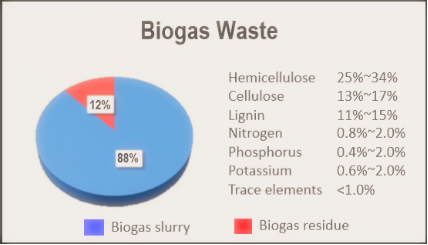Although poultry farming has been increasing in popularity in Africa over the years, it has essentially been a small-scale activity. In the last few years, however, it has become a serious venture, with many young entrepreneurs targeting the attractive profits on offer. Poultry populations of over 5 000 are now quite common but the move to large-scale production has raised public concern over proper waste disposal. This issue, interestingly, also offers value opportunities.
Larger-scale production has presented numerous challenges, especially those relating to waste disposal. Small-scale businesses do not attract much attention from environmental authorities but business operations with environmental issues are required to follow the same environmental safety standards.
Interestingly, the manure waste challenge is offering farmers the opportunity to solve a major problem: the availability and cost of power. In some African countries, many industries complain about the high cost of power and many urban residents use generators because power is unreliable. The transformation of waste manure into electricity through the use of biodigesters has become an attractive prospect, and many farmers are turning to it.
Conversion of manure waste into electricity is more than a bonus, because electricity is a scarce commodity in some African countries. The biodigester is easy to manage, and the cost is reasonable, especially when you look at the long-term benefits
In addition to biogas power generation, however, biogas waste, a by-product of biodigester project, will pollute the environment directly due to its large amount, high concentration of ammonia nitrogen and organic matter, and the cost of transportation, treatment and utilization is high. The good news is biogas waste from biodigester has a better recycling value, so how do we make full use of biogas waste?
The answer is biogas fertilizer. Biogas waste has two forms: one is liquid (biogas slurry), accounting for about 88% of the total. Second, solid residue (biogas residue), accounting for about 12% of the total. After biodigester waste is extracted, it should be precipitated for a period of time (secondary fermentation) to make the solid and liquid separate naturally. Solid – liquid separator can also be used to separate liquid and solid residue biogas waste. Biogas slurry contains nutrient elements such as available nitrogen, phosphorus and potassium, as well as trace elements such as zinc and iron. According to the determination, the biogas slurry contains total nitrogen 0.062% ~ 0.11%, ammonium nitrogen 200 ~ 600 mg/kg, available phosphorus 20 ~ 90 mg/kg, available potassium 400 ~ 1100 mg/kg. Because of its quick effect, high nutrient utilization rate, and can be quickly absorbed by crops, it is a kind of better multiple quick effect compound fertilizer. Solid biogas residue fertilizer, nutrient elements and biogas slurry are basically the same, containing 30% ~ 50% organic matter, 0.8% ~ 1.5% nitrogen, 0.4% ~ 0.6% phosphorus, 0.6% ~ 1.2% potassium, but also rich in humic acid more than 11%. Humic acid can promote the formation of soil aggregate structure, enhance soil fertility retention and impact, improve soil physical and chemical properties, soil amelioration effect is very obvious. The nature of biogas residue fertilizer is the same as the general organic fertilizer, which belongs to the late effect fertilizer and has the best long-term effect.
Production technology of using biogas slurry to make liquid fertilizer
The biogas slurry is pumped into the germ breeding machine for deodorization and fermentation, and then the fermented biogas slurry is separated through the solid-liquid separation device. The separation liquid is pumped into the elemental complexing reactor and other chemical fertilizer elements are added for complexing reaction. The complexing reaction liquid is pumped into the separation and precipitation system to remove the insoluble impurities. The separation liquid is pumped into the elemental chelating kettle, and the trace elements needed by crops are added for chelating reaction. After the reaction is completed, the chelate liquid will be pumped into the finished tank to complete bottling and packaging.
Production technology of using biogas residue to make organic fertilizer
The separated biogas residue was mixed with straw, cake fertilizer and other materials crushed to a certain size, and the moisture content was adjusted to 50%-60%, and the C/N ratio was adjusted to 25:1. Fermentation bacteria are added into the mixed material, and then the material is made into a compost pile, the width of the pile is not less than 2 meters, the height is not less than 1 meters, the length is not limited, and the tank aerobic fermentation process can also be used. Pay attention to the change of moisture and temperature during fermentation to keep the aeration in the pile. In the early stage of fermentation, the moisture should not be less than 40%, otherwise it is not conducive to the growth and reproduction of microorganisms, and the moisture should not be too high, which will affect the ventilation. When the temperature of the pile rises to 70℃, the compost turner machine should be used to turn the pile until it is completely rotted.
Deep processing of organic fertilizer
After the material fermentation and maturation, you can use organic fertilizer making equipment for deep processing. First, it is processed into powdery organic fertilizer. The production process of powdery organic fertilizer is relatively simple. First, the material is crushed, and then the impurities in the material are screened out by using a screening machine, and finally the packaging can be completed. But processing into granular organic fertilizer, granular organic production process is more complex, the first material to crush, screen out impurities, the material for granulation, and then the particles for drying, cooling, coating, and finally complete the packaging. The two production processes have their own advantages and disadvantages, the powder organic fertilizer production process is simple, the investment is small, suitable for the newly opened organic fertilizer factory, the granular organic fertilizer production process is complex, the investment is high, but the granular organic fertilizer is not easy to agglomerate, the application is convenient, the economic value is higher.
Post time: Jun-18-2021


